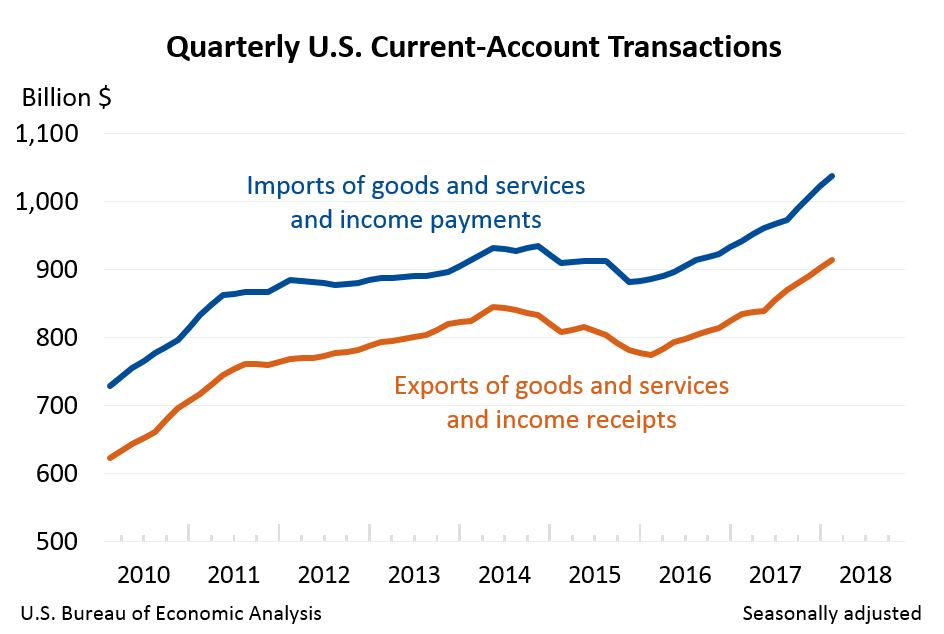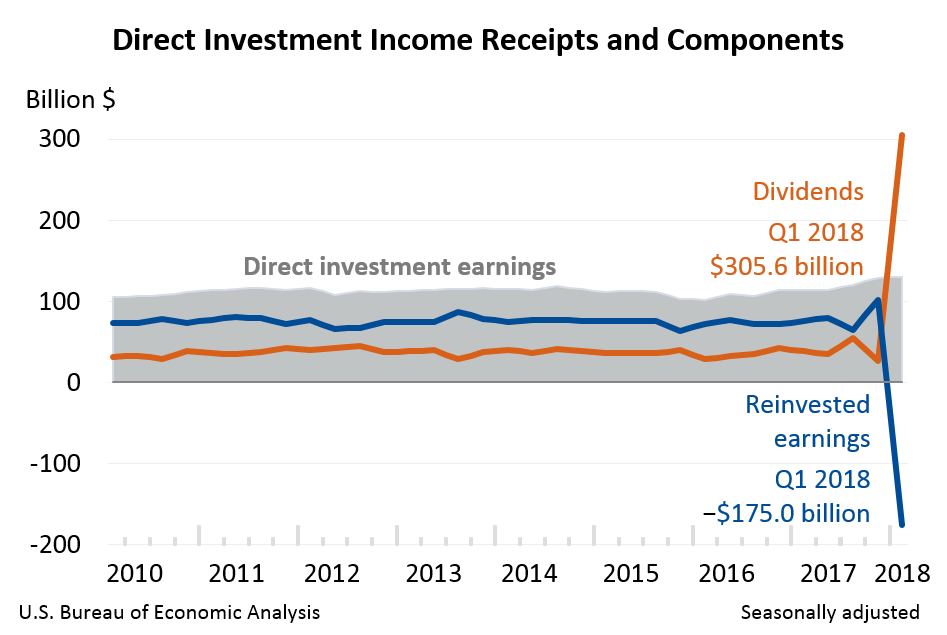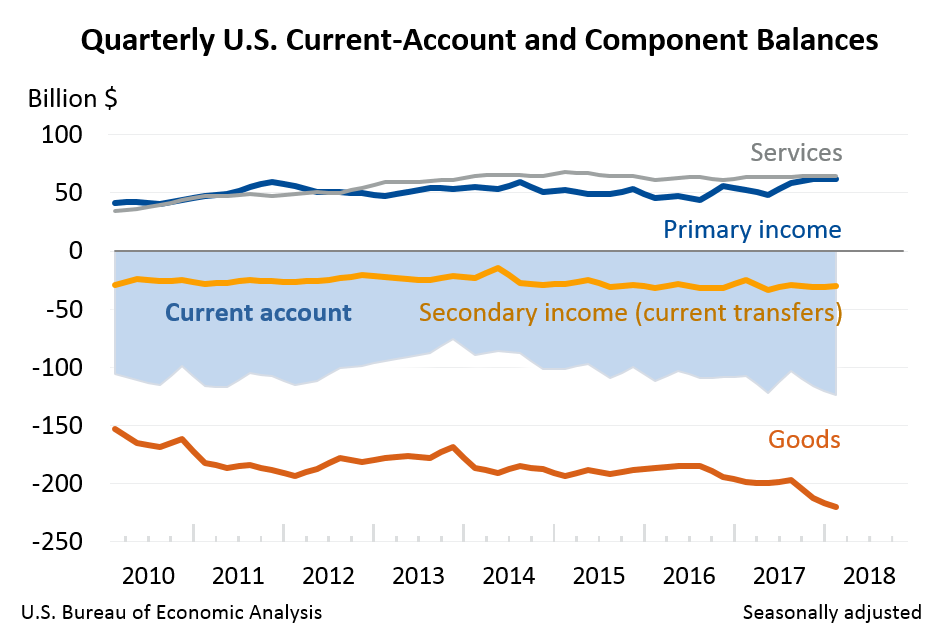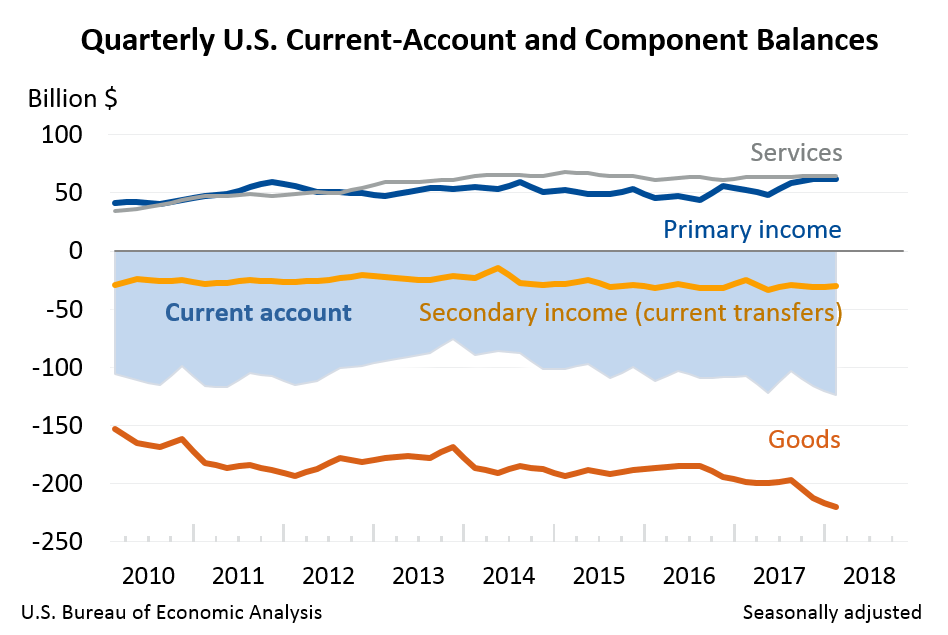News Release
These data have been superseded. Please see our latest releases for current estimates and contact information.
U.S. International Transactions, 1st quarter 2018 and annual update
Current-Account Balance
The U.S. current-account deficit increased to $124.1 billion (preliminary) in the first quarter of 2018 from $116.1 billion (revised) in the fourth quarter of 2017, according to statistics released by the Bureau of Economic Analysis (BEA). The deficit was 2.5 percent of current-dollar gross domestic product (GDP) in the first quarter, up from 2.4 percent in the fourth quarter.
The $8.0 billion increase in the current-account deficit reflected an $8.1 billion increase in the deficit on goods and relatively small and nearly offsetting changes in the balances on services, primary income, and secondary income.

Current-Account Transactions (tables 1-5)
Exports of goods and services and income receipts
Exports of goods and services and income receipts increased $23.0 billion in the first quarter
to $913.4 billion.
* Primary income receipts increased $9.8 billion to $258.8 billion, reflecting increases in
direct investment income, portfolio investment income, and other investment income. For
more information on direct investment income, see the box “Effects of the 2017 Tax Cuts
and Jobs Act on Components of Direct Investment.”
* Goods exports increased $9.5 billion to $411.4 billion, mostly reflecting increases in
automotive vehicles, parts, and engines, in consumer goods, primarily jewelry and collectibles,
and in nonmonetary gold.
Imports of goods and services and income payments
Imports of goods and services and income payments increased $30.9 billion in the first quarter
to $1,037.5 billion.
* Goods imports increased $17.6 billion to $631.9 billion, mostly reflecting increases in
industrial supplies and materials, primarily petroleum and products, and in consumer goods,
primarily medicinal, dental, and pharmaceutical products.
* Primary income payments increased $10.2 billion to $196.8 billion, reflecting increases in
direct investment income, portfolio investment income, and other investment income.
BOX.___________________________________________________________________________________________
Effects of the 2017 Tax Cuts and Jobs Act on Components of Direct Investment
In the international transactions accounts, income on equity, or earnings, of foreign affiliates
of U.S. multinational enterprises in a period typically consists of a portion that is repatriated
to the parent company in the United States in the form of dividends and a portion that is reinvested
in foreign affiliates. At times, repatriation of dividends exceeds current-period earnings,
resulting in negative values being recorded for reinvested earnings. In the first quarter of 2018,
direct investment earnings were $130.6 billion, reflecting dividends and withdrawals of $305.6
billion and reinvested earnings of -$175.0 billion (table 4).
The large magnitudes for dividends and withdrawals and the negative reinvested earnings reflect
the repatriation of accumulated earnings by foreign affiliates of U.S. multinational enterprises
to their parent companies in the United States in response to the 2017 Tax Cuts and Jobs Act
(TCJA). The TCJA requires U.S. parent companies to pay a one-time tax on their accumulated earnings
held abroad, but generally eliminates taxes on repatriated earnings. The negative reinvested
earnings of -$175.0 billion reflect the fact that dividends exceeded earnings in the first quarter
and U.S parent companies withdrew accumulated prior earnings from their foreign affiliates. The
negative reinvested earnings are also reflected in the net acquisition of direct investment assets
in the financial account, which was -$119.7 billion* in the first quarter of 2018 (table 6).
For more information, see “How does the 2017 Tax Cuts and Jobs Act affect BEA's business income
statistics?” and “How are the international transactions accounts affected by an increase in
direct investment dividend receipts?”
*This number was originally reported as -$119.6 billion; it was corrected on June 28, 2018.

_______________________________________________________________________________________________
Financial Account (tables 1, 6, 7, and 8)
Net U.S. borrowing measured by financial-account transactions was $180.6 billion in the first
quarter, an increase from net borrowing of $31.3 billion in the fourth quarter.
Financial assets
Net U.S. acquisition of financial assets excluding financial derivatives increased $127.6 billion
in the first quarter to $254.7 billion.
* Net U.S. acquisition of portfolio investment assets increased $277.2 billion to $365.5
billion, reflecting net U.S. purchases of foreign equity and investment fund shares following
net sales in the fourth quarter.
* Net U.S. acquisition of other investment assets was $8.9 billion following net liquidation
of $50.9 billion in the fourth quarter. This change mostly reflected net U.S. provision of
loans to foreigners following net foreign repayment in the fourth quarter.
* Net U.S. withdrawal of direct investment assets was $119.7 billion following net U.S.
acquisition of $91.3 billion in the fourth quarter. This change partly offset the changes
in portfolio investment assets and other investment assets. The net withdrawal of direct
investment assets reflected U.S. parent repatriation of previously reinvested earnings in
response to the TCJA. For more information, see the box “Effects of the 2017 Tax Cuts and
Jobs Act on Components of Direct Investment.”
Liabilities
Net U.S. incurrence of liabilities excluding financial derivatives increased $304.9 billion in the
first quarter to $464.1 billion.
* Net U.S. incurrence of portfolio investment liabilities increased $210.5 billion to $292.1
billion, mostly reflecting net foreign purchases of U.S. equity and investment fund shares
following net foreign sales in the fourth quarter.
* Net U.S. incurrence of direct investment liabilities increased $59.1 billion to $97.3 billion,
mostly reflecting net U.S. incurrence of debt instrument liabilities following net repayment
in the fourth quarter.
* Net U.S. incurrence of other investment liabilities increased $35.3 billion to $74.6 billion,
reflecting partly offsetting changes in transactions in loan and deposit liabilities. Net
U.S. incurrence of loan liabilities in the first quarter followed net repayment in the fourth
quarter. Net foreign withdrawal of deposits in the United States followed net incurrence in
the fourth quarter.
Financial derivatives
Transactions in financial derivatives other than reserves reflected first-quarter net lending of
$28.7 billion, a $27.9 billion increase from the fourth quarter.
Statistical Discrepancy (table 1)
The statistical discrepancy was -$56.5 billion in the first quarter following a statistical
discrepancy of $84.9 billion in the fourth quarter.
Updates to Fourth Quarter 2017 International Transactions Accounts Aggregates
Billions of dollars, seasonally adjusted
Preliminary estimate Revised estimate
Current-account balance -128.2 -116.1
Goods balance -214.3 -212.4
Services balance 60.4 64.6
Primary-income balance 57.2 62.4
Secondary-income balance -31.5 -30.7
Net lending (+)/borrowing (-) from
financial-account transactions -29.8 -31.3
Statistical discrepancy 98.4 84.9
Annual Update of the International Transactions Accounts (table 9)
The statistics in this release reflect the annual update of the U.S. international transactions
accounts. With this update, BEA has incorporated improved estimation methodologies, newly available
and revised source data, and updated seasonal adjustments. Key changes to the statistics are
summarized below and in table 9.
* The revised statistics on the international transactions accounts incorporate newly available
and revised source data for 2014–2017 and for additional years for selected components as
described below.
* Revised statistics on exports of goods reflect an improved method for estimating exports
under the U.S. Foreign Military Sales (FMS) program. Beginning with statistics for 2010,
BEA is no longer replacing FMS exports in the U.S. Census Bureau’s merchandise trade statistics
with data from the U.S. Department of Defense. This change in methodology also affects the
financial account because the value of exports of FMS goods is recorded under general
government trade credits and advances as a reduction in the liabilities of the U.S. government.
U.S. government liabilities, which reflect pre-payments made by foreign purchasers, are
reduced when the foreign purchaser takes ownership of the goods.
* Revised statistics on exports of government goods and services reflect an improved method
for estimating exports of goods and services under U.S. military grant programs. BEA has
identified that cash grants disbursed through the Afghanistan Security Forces Fund program
are included in the source data for government goods and services and has removed them
beginning with statistics for 2010. These cash grants are captured in BEA’s source data on
U.S. government grants and recorded as a debit in secondary income payments in the current
account and as a credit in other investment liabilities in the financial account. No adjustment
to other investment is necessary because these cash grants, while not identifiable, are
captured in BEA’s source data on financial transactions.
* Revised statistics on direct investment positions, transactions in financial assets and
liabilities, and related income receipts and payments for 2014–2017 incorporate the results
of BEA’s 2014 Benchmark Survey of U.S. Direct Investment Abroad. This survey collects data
on the U.S. and foreign operations of all U.S. investors that own 10 percent or more of a
foreign business enterprise. For more information, see “Activities of U.S. Multinational
Enterprises in the United States and Abroad: Preliminary Results From the 2014 Benchmark
Survey” in the December 2016 issue of the Survey of Current Business.
* Revised statistics on exports of travel services for 2015–2017 incorporate adjustments to
address an undercount of foreign visitors to the United States in BEA’s source data. For
more information, see “How did the International Trade Administration’s suspension of I-94
arrivals data releases affect BEA’s statistics?”
Newly Available and Revised Source Data: Key Providers and Years Affected
BEA:
* Benchmark Survey of U.S. Direct Investment Abroad (2014–2017)
* Quarterly international services surveys (2015–2017)
* Quarterly direct investment surveys (2015–2017)
* Annual direct investment surveys (2015–2017)
U.S. Census Bureau:
* Foreign Military Sales (2010-2017)
* Revised source data for Census-basis goods (2015–2017)
U.S. Customs and Border Protection
* BEA adjustments to source data on country of residency of visitors to the United States
(2015–2017)
* Number of U.S. citizens traveling abroad (2016–2017)
U.S. Department of the Treasury:
* Annual and benchmark surveys from the Treasury International Capital system (2016–2017)
A more detailed discussion of the new estimation methodologies and other changes appears in
“Preview of the 2018 Annual Update of the International Economic Accounts” in the May 2018 issue
of the Survey of Current Business. Additional information on the updates to the U.S. international
transactions accounts and the U.S. international investment position accounts will be provided
in the July issue of the Survey of Current Business.
Next release: September 19, 2018 at 8:30 A.M. EDT
U.S. International Transactions, Second Quarter 2018

